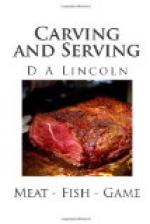This is a difficult joint for a beginner, but after a little study and practice one may manipulate it with dexterity. Some time when a lamb stew or fricassee is to be prepared, study the joint carefully and practice cutting it up, and thus become familiar with the position of the shoulder-blade joint,—the only one difficult to reach. The backbone should always be disjointed. The ribs should be divided across the breast and at the junction of the breast-bone, and the butcher should also remove the shoulder-blade and the bone in the leg. Unless the joint be very young and tender, it is better to use the breast portion for a stew or fricassee; but when nice and tender the breast may be roasted with the other portions, as the choice gelatinous morsels near the breast-bones are preferred by many. This joint consists of three portions,—the shoulder or knuckle, the breast or brisket, and the ribs. Put it on the platter with the backbone up. Put the fork in near the knuckle. Cut through the flesh clear round the leg and well up on the shoulder, but not too far on the breast. With the fork lift the leg away from the shoulder, cutting in till you come to the joint, after separating which, remove the leg to a separate dish, to be afterward cut into thin slices through the thickest part. Cut across from left to right where the ribs have been broken, separating the gristly breast from the upper portion. Then remove the blade if it has not been done before cooking. Divide each of these portions between the ribs, and serve a piece of the rib, the breast, or a slice from the leg, as preferred.
NECK OF VEAL.
The vertebra should be disjointed, and the ribs cut on the inside through the bone only, on the thin end. Place it on the platter with the back up and cut across from left to right, where the ribs were divided, separating the small ends of the ribs from the thicker upper portion; then cut between each short rib. Carve from the back down in slanting slices, then slip the knife under close to the ribs and remove the slices. This gives a larger portion than the cutting of the slices straight would give, and yet not so large as if each were helped to a whole rib. Serve a short rib with each slice.
BREAST OF VEAL.
Place it on the dish with the breast-bone or brisket nearest you. Cut off the gristly brisket, then separate it into sections. Cut the upper part parallel with the ribs, or between each rib if very small. Slice the sweetbread, and serve a portion of brisket, rib, and sweetbread to each person.




